 W
WIn martial arts and tricking, the 540 kick is a jump kick move. It involves a rotation of approximately 540 degrees.
 W
WAn aerial cartwheel or side aerial is an acrobatic move in which a cartwheel is executed without touching hands to the floor. During the execution of a standard cartwheel, the performer's body is supported by the hands while transitioning through the inverted orientation whereas an aerial cartwheel, performer is airborne while inverted. To compensate for lack of support from the hands, leg momentum is employed to keep the performer airborne until the leading foot touches down. Aerial cartwheels can be executed while running or from a stationary, standing position. The front leg lunges and the back leg drives back creating momentum. Aerial cartwheels are also known by various other names, including side flip, side somersault, air cartwheel, no-hands cartwheels, or simply aerials.
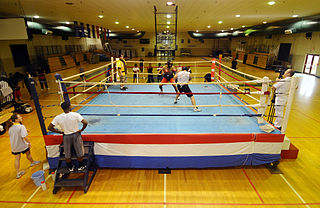 W
WAliveness, also referred to as alive training describes martial arts training methods that are spontaneous, non-scripted, and dynamic. Alive training is performed with the intent to win, rather than for mastery or demonstration purposes as in regular sparring, where victory is not an option. Aliveness has also been defined in relation to martial arts techniques as an evaluation of combat effectiveness. Some trainers, like Cus D'Amato, Kevin Rooney, Floyd Mayweather Sr., resort to the alive training, requesting both their trainees and sparring partners to do their best. Such method became known as the wars in the gym. Others, like Angelo Dundee, prefer rather mild and less extreme methods.
 W
WAshi guruma is a throw in judo. It is one of the original 40 throws of Judo as developed by Kano Jigoro. It belongs to the third group of the traditional throwing list in the Gokyo no waza of the Kodokan Judo. It is also included in the current 67 Throws of Kodokan Judo and is classified as a foot technique (ashiwaza).
 W
WIn martial arts, blocking is the act of stopping or deflecting an opponent's attack for the purpose of preventing injurious contact with the body. A block usually consists of placing a limb across the line of the attack.
 W
WBreaking is a martial arts technique that is used in competition, demonstration and testing. Breaking is an action where a martial artist uses a striking surface to break one or more objects using the skills honed in their art form. The striking surface is usually a hand or a foot, but may also be a fingertip, toe, head, elbow, knuckle, or knee. The most common object is a piece of wood or brick, though it is also common to break cinder blocks, glass, or even a piece of metal such as steel bars. Glass is usually discouraged, since its shards may cause injury when broken.
 W
WA butterfly kick or horse kick is a jumping kick in martial arts such as modern wushu and taekwondo and capoeira. In certain changchuan styles, this kick is known as Swallow Kick.
 W
WClinch fighting is the part of stand-up fighting where the combatants are grappling in a clinch, typically using clinch holds. Clinching the opponent can be used to eliminate the opponent's effective usage of some kicks, punches, and melee weapons. The clinch can also be used as a medium to switch from stand-up fighting to ground fighting by using takedowns, throws or sweeps.
 W
WDaki Age (抱上) is a throw in judo. It is one of the techniques adopted later by the Kodokan into the Shinmeisho No Waza list. It is categorized as a hip technique, Koshi-waza. In practice it is very similar to a body slam, the object being for tori to lift uke while in his guard subsequently forcefully dropping uke onto their back. This is a very dangerous technique that has the potential to cause spinal injuries. Generally uke will release their guard if they cannot prevent the lift.
 W
WDeashi Harai (出足払), more accurately romanized: Deashibarai, is one of the original 40 throws of Judo as developed by Jigoro Kano. It belongs to the first group, Dai-Ikkyo, of the traditional throwing list, Gokyo-no-Nagewaza, of Kodokan Judo. It is also part of the current 67 Throws of Kodokan Judo. It is classified as a foot technique, Ashi-Waza. Deashi Harai is also one of the 20 techniques in Danzan Ryu's (DZR) Nagete list.
 W
WDo-jime is a chokehold in judo. It is one of the twelve constriction techniques of Kodokan Judo in the Shime-waza list. Do-Jime is one of the four forbidden techniques, Kinshi-waza. Do-jime is also a prohibited technique in Judo competitions, and is considered a 'slight infringement' according to IJF rules, Section 27: Prohibited acts and penalties, article 21
 W
WEye-gouging is the act of pressing or tearing the eye using the fingers or instruments. Eye-gouging involves a very high risk of eye injury, such as eye loss or blindness.
 W
WMortal Kombat II is a fighting game originally produced by Midway for the arcades in 1993. It was later ported to multiple home systems, including the MS-DOS, Amiga, Game Boy, Game Gear, Sega Genesis, 32X, Sega Saturn, Super Nintendo Entertainment System, and PlayStation only in Japan, mostly in licensed versions developed by Probe Entertainment and Sculptured Software and published by Acclaim Entertainment.
 W
WFighting Woman News was an American feminist periodical founded in 1975. Published quarterly by Spectrum Resources, the magazine wrote and advocated about martial arts, self-defense, and combative sports for and by women. It published news and articles on techniques, workshops, and events. Fighting Woman News also regularly sent representatives to women’s conferences to promote self-defense and martial arts literature for women.
 W
WFish-hooking is the act of inserting a finger or fingers of one or both hands into the mouth, nostrils or other orifices of a person, and pulling away from the centerline of the body; in most cases with the intention of pulling, tearing, or lacerating the surrounding tissue. Forceful fish-hooking involves a high risk of permanent facial or orifice damage. Sometimes, the term fish hooking refers to a type of eye gouging.
 W
WThe foot sweep is a move in many different styles of martial arts. It is used to trip an opponent. Foot sweeps are commonly used in Tang Soo Do, karate, Muay Thai and jujutsu. In addition, many closer sweeps like the Trap Sweep and Two-Leg Sweep can resemble Judo throws.
 W
WThe front kick in martial arts is a kick executed by lifting the knee straight forward, while keeping the foot and shin either hanging freely or pulled to the hip, and then straightening the leg in front of the practitioner and striking the target area. It is desirable to retract the leg immediately after delivering the kick, to avoid the opponent trying to grapple the leg and to return to stable fighting stance.
 W
WGrappling, in hand-to-hand combat, describes sports that consist of gripping or seizing the opponent. Grappling is used at close range to gain a physical advantage over an opponent, either by imposing a position or causing injury. Grappling is a broad term that encompasses many disciplines. These various martial arts can be practiced both as combat sports and for self-defense. Grappling contests often involve takedowns and ground control, and may end when a contestant concedes defeat, also known as a submission or tap out.
 W
WGround fighting is hand-to-hand combat which takes place while the combatants are on the ground. The term is commonly used in mixed martial arts and other combat sports, as well as various forms of martial arts to designate the set of grappling techniques employed by a combatant that is on the ground. It is the main focus of Brazilian Jiu-Jitsu and is featured in varying amounts in Catch wrestling, Judo, Sambo, Shoot wrestling, Dishuquan Dog Kung Fu, some schools of Shuai Jiao and other styles of wrestling.
 W
WHane goshi is a throw in judo. It is one of the original 40 throws of Judo as developed by Jigoro Kano. It belongs to the third group, Sankyo, of the traditional throwing list, Gokyo, of Kodokan Judo. It is also part of the current 67 Throws of Kodokan Judo. It is classified as a hip technique, Koshi-Waza. Hane goshi is also one of the 20 techniques in Danzan Ryu's Nagete list.
 W
WHane Makikomi (跳巻込) is one of the original 40 throws of Judo as developed by Jigoro Kano. It belongs to the fourth group, Yonkyo, of the traditional throwing list, Gokyo, of Kodokan Judo. It is also part of the current 67 Throws of Kodokan Judo.
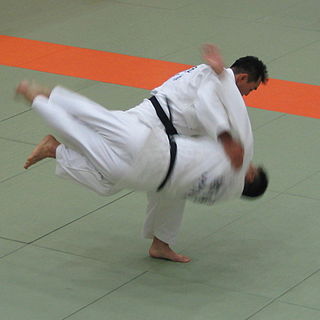 W
WHarai goshi (払腰) is one of the original 40 throws of Judo as developed by Kano Jigoro. It belongs to the second group of the traditional throwing list in the Gokyo no waza of the Kodokan Judo. It is also part of the current 67 Throws of Kodokan Judo, and classified as a hip technique (koshiwaza). Harai goshi is also one of the 20 techniques in Danzan ryu's Nagete list as well as one of the 18 throws in the Kar-do-Jitsu-Ryu martial arts system. English terms include "Sweeping hip throw" and "Hip Sweep".
 W
WHarai Tsurikomi Ashi (払釣込足) is one of the original 40 throws of Judo as developed by Jigoro Kano. It belongs to the third group, Sankyo, of the traditional throwing list, Gokyo, of Kodokan Judo. It is also part of the current 67 Throws of Kodokan Judo. It is classified as a foot technique, Ashi-waza.
 W
WHiza guruma (膝車) is one of the original 40 throws of Judo as developed by Kano Jigoro. It belongs to the first group of the traditional throwing list in the Gokyo no waza of the Kodokan Judo. It is also included in the current 67 throws of Kodokan Judo. It is classified as a foot technique (ashiwaza).
 W
WThe ippon seoi nage (一本背負投) is a throw in judo. It is a variant of Seoi nage, and is one of the nineteen accepted techniques in Shinmeisho No Waza of Kodokan Judo. It is classified as a hand throwing technique, or te-waza.
 W
WKata guruma (肩車) is one of the traditional forty throws of judo as developed by Kano Jigoro. Kata guruma belongs to the third group of the traditional throwing list in the Gokyo no waza of the Kodokan Judo. It is also part of the current 67 Throws of Kodokan Judo. Because the technique is not a sweep nor a trip and requires tori to pull uke into a carry, it is categorized as a hand throwing technique (tewaza).
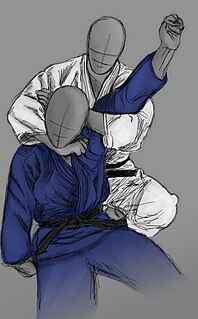 W
WKata-Ha-Jime (片羽絞), also spelled Katahajime, is a chokehold in judo. It is one of the twelve constriction techniques of Kodokan Judo in the Shime-waza list.
 W
WKata Jūji-jime (片十字絞) is a chokehold in judo. It is one of the twelve constriction techniques of Kodokan Judo in the
 W
WA kick is a physical strike using the leg, in unison usually with an area of the knee or lower using the foot, heel, tibia (shin), ball of the foot, blade of the foot, toes or knee. This type of attack is used frequently by hooved animals as well as humans in the context of stand-up fighting. Kicks play a significant role in many forms of martial arts, such as capoeira, kalaripayattu, karate, kickboxing, kung fu, MMA, Muay thai, pankration, pradal serey, savate, sikaran, silat, taekwondo, vovinam, and Yaw-Yan. Kicks are a universal act of aggression among humans.
 W
WA kip-up is an acrobatic move in which a person transitions from a supine, and less commonly, a prone position, to a standing position. It is used in activities such as breakdancing, gymnastics, martial arts, professional wrestling, and freerunning, and in action film fight sequences.
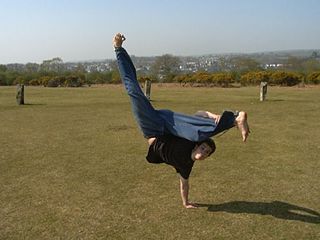 W
WAn L-kick, also called aú batido, is a movement in breakdancing, capoeira and other martial arts and dance forms. It is executed by throwing the body into a cartwheel motion, but rather than completing the wheel, the body flexes while supported by one hand on the ground. One leg is brought downwards and forwards in a kicking motion while the other remains in the air.
 W
WA meia lua de compasso is a technique found in the martial art of capoeira that combines an evasive maneuver with a reverse roundhouse kick. It is considered one of the most powerful and efficient kicks of the art and one of its most iconic movements along with the rasteira. It is even considered that a capoeirista's general skill level can be determined on how hard and fast they are able to execute a meia lua de compasso.
 W
WA nip-up is an acrobatic spring from a supine position to a standing position. It is executed by propelling the body away from the floor so that the performer is momentarily airborne, and typically ends with the performer standing in a squatting position. It is performed in a variety of activities, including acro dance, breakdancing, gymnastics, martial arts, professional wrestling, parkour and freerunning.
 W
WOkuriashi harai (送足払) is one of the original 40 throws of Judo as developed by Kano Jigoro. It belongs to the second group of the traditional throwing list in the Gokyo no waza of the Kodokan Judo. It is also part of the current 67 Throws of Kodokan Judo. It is classified as a foot technique (ashiwaza).
 W
WOpen-hand strikes include various techniques used in the martial arts to attack or defend without curling the hand into a fist. The most famous of these techniques is probably the so-called "karate chop", which is also described as a knife-hand strike although there are many other techniques.
 W
WA pin, or fall, is a victory condition in various forms of wrestling that is met by holding an opponent's shoulders or scapulae on the wrestling mat for a prescribed period of time. This article deals with the pin as it is defined in amateur wrestling.
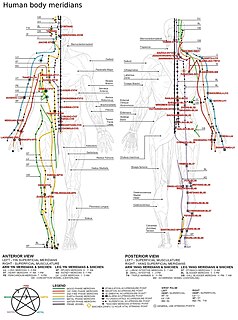 W
WPressure points derive from the meridian points in Traditional Chinese Medicine and Indian Ayurveda and Siddha medicine, and the field of martial arts, and refers to an area on the human body that may produce significant pain or other effects when manipulated in a specific manner.
 W
WA punch is a striking blow with the fist.
 W
WA roundhouse kick is a kick in which the practitioner lifts their knee while turning the supporting foot and body in a semicircular motion, extending the leg striking with the lower part of the shin and/or the instep the ball of the foot can also be used to strike the target and is preferable when power breaking thick boards. This type of kick is utilized in many different martial arts and is popular in both non-contact and full-contact martial arts competitions. The kick has many variations based on stance, leg movement, striking surface, and the height of the kick.
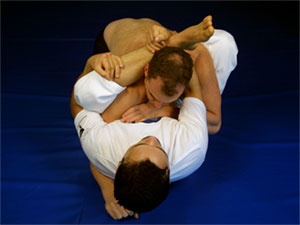 W
WThe rubber guard is a Brazilian Jiu-jitsu technique, which involves the practitioner ‘breaking down’ the opponent into the rubber guard, while maintaining a high level of control. It utilizes extensive flexibility to control the opponent with one arm and one leg. The opposite arm in turn is free to attempt submissions, sweeps or to strike the trapped head of the opponent.
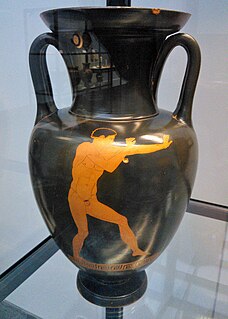 W
WIn martial arts, stances are the distribution, foot orientation and body positions adopted when attacking, defending, advancing, or retreating. In many Asian martial arts, the most widely used stance is a shallow standing squat. This position is generally employed as it is a neutral and agile position from which both attacks and defences may be launched. It provides for the delivery of force when attacking and stability when defending.
 W
WA strike is a directed physical attack with either a part of the human body or with an inanimate object intended to cause blunt trauma or penetrating trauma upon an opponent.
 W
WA sweep is either of two categories of martial arts techniques. From standing, sweeps are throws or takedowns that primarily use the legs to attack an opponent's legs. On the ground, sweeps are techniques for reversing a grappling position.
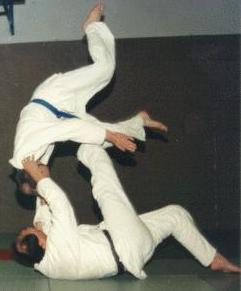 W
WIn martial arts, a throw is a grappling technique that involves off-balancing or lifting an opponent, and throwing them to the ground, in Japanese martial arts referred to as nage-waza, 投げ技, "throwing technique". Throws are a subset of takedown (grappling). Certain throwing techniques called sacrifice throws involve putting oneself in a potentially disadvantageous position, such as on the ground, in order to execute a throw.
 W
WA transition in grappling is a move from one grappling hold or grappling position to another. The process is called transitioning and is one of the most important aspects of ground grappling, as it allows the combatant performing the transition to advance in positioning, for instance by using a sweep, or to attempt pinning holds or submission holds.
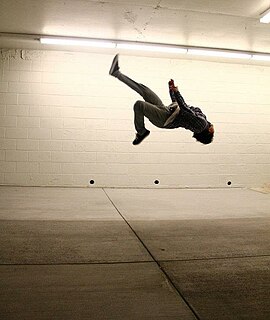 W
WTricking is a training discipline that combines kicks with flips and twists from martialarts and gymnastics as well as many dance moves and styles from breakdancing. It aims to achieve an aesthetic display of different combinations of "tricks". Tricking practitioners are commonly referred to as trickers. Examples of tricking techniques include the 540 kick, the corkscrew (cork), the flashkick, the butterfly twist and the double leg.